

ATom-1, the first of four ATom deployments over the next few years, is about to wind down. We’ve covered over 60,000 km and flown all the way around the world, but unlike the Jules Verne classic, it took us only 24 days (and not 80) to make it back to Palmdale, California. I managed not to get sick (or break any bones, which is an achievement if you know me!), despite the nearly 100 flight hours and lots of sleep deprivation.
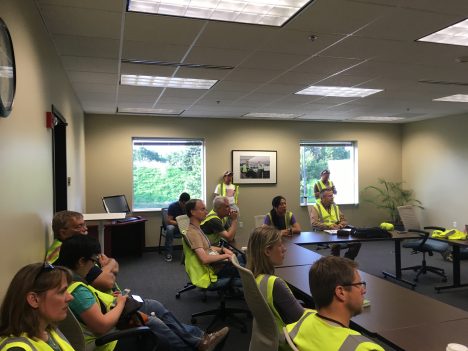
Tired ATom scientists at our final pre-flight briefing. Photo by Róisín Commane
I have found the second half of the ATom-1 deployment a lot more challenging than the first half. Some of the challenge was the constant changing of location and lack of routine outside of the aircraft. It has gotten to the stage that I might not know what city I’m in, what day it is or what the local time is, but I can get the instrument ready to measure. That’s both comforting and a little disturbing!

Róisín Commane trying to stay warm on the final ATom flight. Photo by Róisín Commane
Some of the challenge was the fatigue brought on by the long length of working days on the aircraft and time changes, the effects of which I didn’t fully appreciate beforehand. On a typical flight day we wake up at 3 a.m. to shower and pack our bags, we start preparing the instrument for the flight at 4 a.m., we take off at 7 a.m., fly and measure for 10 hours, and land at 5 p.m. if we don’t change time zones. As we constantly fly to a new location, it then takes another hour or two to get off the aircraft and to the hotel. With such a long flight day, all I’m able to do after a flight is fall into bed – ideally after finding some food!
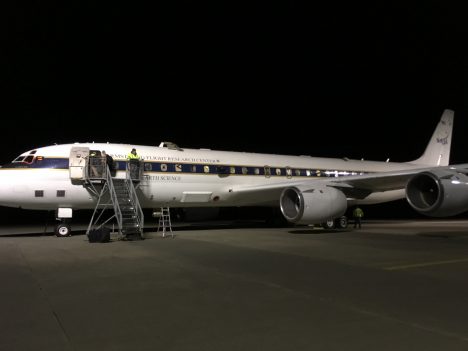
Preparing to leave Punta Arenas, Chile in the dark. Photo by Róisín Commane
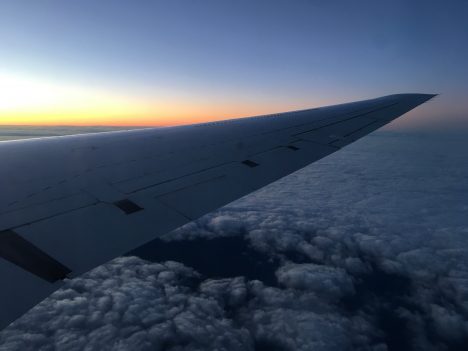
Flying into the sunrise. Photo by Róisín Commane
Flying east was a lot harder than flying west and to help this I think we are planning an extra day in Punta Arenas, Chile for ATom-2. We needed more than a day to get back on track after an 8 hour time change. It was winter in Punta Arenas this time so it was a little too cold to spend long in the sunshine (to encourage my sleep cycle to normalize). But in February, it will be southern hemisphere summer and being outside will be much easier. And hopefully I will fulfill a long-time ambition and see a penguin in the wild next time too! And not just a black and white cormorant that looks like a penguin!
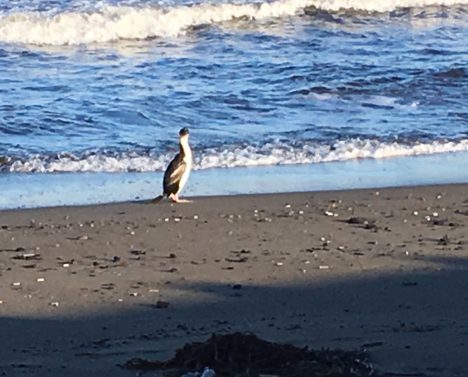
A cormorant on the beach in Punta Arenas, Chile. Hopefully next time I’ll see a penguin! Photo by Róisín Commane
As the first phase of the ATom project draws to a close, I am still surprised at just how far the influence of land, and fires in particular, can travel through the atmosphere.
Most of the time, the influence of land (and pollution that people generate) can only be seen a few miles from shore. When flying south into Alaska from the Arctic ocean, we saw the tell-tale chemicals of land influence about three miles offshore; uptake by plants reduced the amount of carbon dioxide (CO2) and increased the methane from emission from wetlands. Flying from James’ Bay in over the Hudson Bay Lowlands, we saw an even larger increase in methane a mile offshore than we saw in Alaska. I should not have been surprised, because Hudson Bay Lowlands are the largest source of natural methane in North America.

The Hudson Bay Lowlands in Canada are a large source of methane. Photo by Róisín Commane
But in other places we also saw pollution thousands of miles from shore, in amongst some of the cleanest air in the world. In fact, some layers of pollution were so concentrated that we could see them by just looking out the window. In the photo below you can see a brown/pink layer of pollution that we found hundreds of miles from land as it cuts through the beautiful blue sky and ocean below. In layers like this, CO, other pollution related gases and particles like black carbon will be pretty high. We saw pollution from Asia transported out over the Pacific ocean and pollution from the U.S. over the Atlantic ocean.
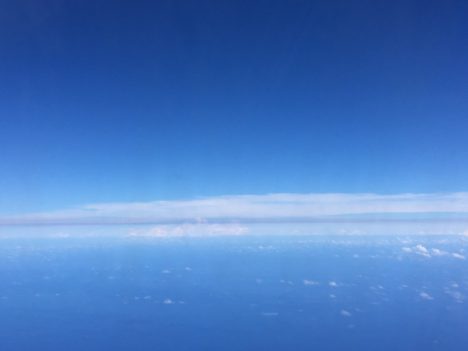
Pollution layers over the Pacific ocean. Photo by Róisín Commane
I’ve learned that pollution can be transported anywhere. The amount of pollution in the Arctic was especially stark. In Greenland we could see the black layers forming on the top of the ice sheet as pollution from far away gets transported to the arctic and deposits on the ice. The black layers absorb more heat than clean ice leading to increased melting at the top of the ice sheet, which forms deceptively beautiful melt ponds on the ice sheet. We met researchers from the UK “Black and Bloom” project (@BlackandBloom) in Kangarlussuaq and heard how some of this black layer can be composed of algae, which will also enhance warming and melting.

Russel Glacier near Kangerlussuaq, Greenland. Photo by Róisín Commane

Bright blue melt ponds on the Greenland Ice Sheet. Photo by Róisín Commane
However, not all pollution is man-made in the typical sense. In the Arctic regions north of Alaska and Greenland, which we sampled almost three weeks apart, we saw the high carbon monoxide (CO) given off by the fires in Siberia. Fires in this area are a part of the natural cycle, but as temperatures have been rising in the Arctic, the frequency and magnitude of big fires like these have increased. In Alaska last year, over five million acres burned. In Canada the year before 11 million acres burned. These regions have carbon rich soils similar to dry peat bogs, that often continue to smolder and incompletely burn long after the hot temperatures of the main burn. Lower temperatures and incomplete burning leads to the release of more CO, soot and other pollutants than for a hot, completely burning fire.
The arctic regions are not the only place we see the influence of very distant fires. We sampled air from fires burning in Africa as we came into land in Ascension Island. As the Island is 1,000 miles from any continent, I was really surprised that the high CO could survive that journey! CO has a lifetime of about a month in the troposphere, and some of the other chemicals are much shorter, so the air has to travel to remote islands like Ascension fairly quickly.
I’m often a little torn by seeing layers of high pollution in the remote atmosphere. While it’s exciting to see high numbers on our instruments, it’s really disappointing to think that the places we think of as pristine see so much human influence. But any time I get a little down, nature has a way of cheering me up: such as when the sun and clouds combine to create a glory around our aircraft. You can tell from where the glory is centered that I was sitting just behind the starboard (right) wing of the aircraft as we ascended through the cloud layer. A glory forms around an aircraft when there are clouds (or water) in the air and the sun is directly behind the aircraft.
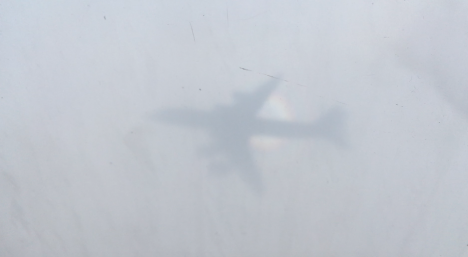
The shadow of the DC-8 on clouds below, haloed by a “glory”. Róisín Commane
The ATom mission is the first to traverse the whole lengths of the Atlantic and Pacific Oceans while making atmospheric measurements from the ocean surface to high altitudes. When we planned ATom, one idea was to compare pollution impacts between the oceans. I expected that human activities would have much greater influence in the Atlantic, because it is smaller than the Pacific and it receives industrial emissions from both sides – the U.S. on the west and Europe to the east. The big emissions from Asia appear to go north to the Arctic, mostly bypassing the Pacific.
Already, our measurements have shown me that our notions did not always match reality. The North Pacific was full of pollutants from Asia, but not from industry as we might have expected—they came mostly from forest fires in the Arctic. Near the coast of California, we did see industrial pollution, but even there, the impact from the large forest and brush fires raging through the Western U.S. this summer was much greater.
So we departed New Zealand and flew to Punta Arenas, Chile, across the tempests of the Southern Ocean off of Antarctica. We found the cleanest air we encountered anywhere, although even there, we could detect very faint traces of soot and other combustion products. It was windy, snowy and cold in Punta Arenas.
Crisp air had arrived from Antarctica, by the time we embarked two days later for the Atlantic. It was just as clean as it looked.
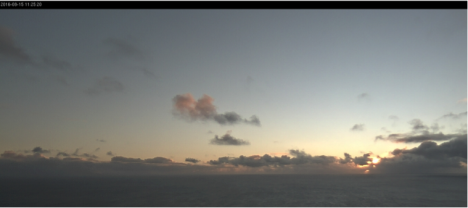
Crisp, clean sunrise seen from 500 ft over the South Atlantic east of Argentina. Photo: NASA DC-8 forward camera.
We headed from Punta Arenas to Ascension Island, a small, isolated, mostly barren volcanic protrusion emerging from the very center of the Atlantic at the Mid-Atlantic ridge, where the ocean basin is created, 12 degrees south of the Equator. It is extremely remote, more than 1000 miles from the nearest land.
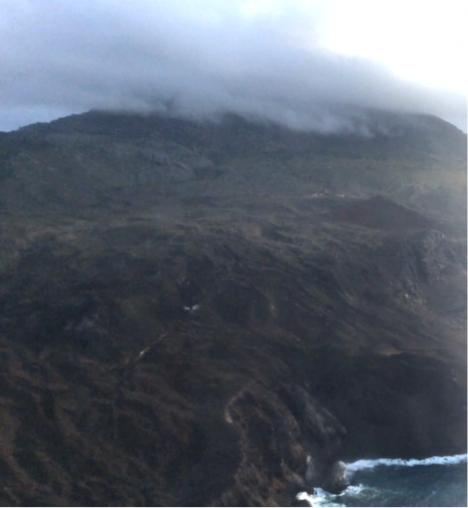
Ascension Island, our destination in the middle of the tropical South Atlantic. Photo: Steven Wofsy
An hour or so after leaving Chile, we crossed the frontal region of stormy weather that separates the wintry middle latitudes from the subtropics and tropics in the south Atlantic—the southern polar jet stream. Air quality started to deteriorate immediately after we had crossed the jet stream, and pollution got stronger and stronger as we approached Ascension. By the time we arrived there, smoke and haze were so thick we could not see the surface of the ocean looking down from above. Here we were — actually dead center in the middle of the ocean — and pollutants from brush and forest fires in Africa were as heavy, or heavier, than the smoke and haze we encountered when we started out in Palmdale, California, where there was a large brush fire nearby and the City of Los Angeles just upwind!
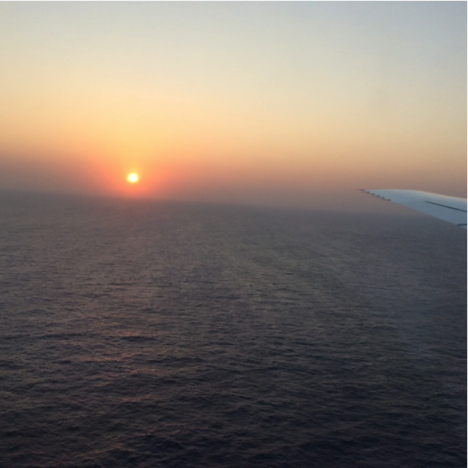
Dense smoke and haze obscure the sunset as we approach Ascension Island, in the center of the tropical Atlantic Ocean. Compare this image with the sunrise that we observed on departing Chile! Photo: Steven Wofsy
I was not surprised to find pollution at Ascension, its presence had, once again, been forecast by our modelers, Junhua Liu and Sarah Strode from Goddard Space Flight Center. But I was stunned at how dense and extensive this pall of haze and noxious gas was. We found quite a bit more than what the models predicted. No wonder we had earlier seen African pollution way out in the Pacific, 3/4 of the world away from the source!
We had wonderful hospitality from the U.S. airbase on Ascension, but this part of the trip was really discouraging. The rocky little island was inhabited by all manner of invasive species—plants, rodents, feral livestock, etc. The accommodations were spartan, and we were mostly cut off from communications with the outside world. The air that we came to study was a mess. We had traversed 12 time zones in a few days, so our bodies wanted to sleep when we needed to be awake and vice versa.
We were thankful to our gracious hosts, but ready to move on to our next destination, Lajes Airfield on Ihla de Terceira in Portugal’s Açore Islands. On this leg of our trip, we crossed the Intertropical Convergence Zone once again. On the north side, there was still a lot of pollution from African biomass fires and a good dose of Saharan dust, too.
We arrived at Lajes just after a storm had passed through, putting us in air from middle latitudes. The air was much cleaner. We stayed at a quiet town, Praia da Vitoria-Santa Cruz, on Ihla Terceira, with comfortable lodgings and excellent restaurants that emphasized local seafood and produce. It reminded me of the fresh-as-ever cuisine of Provence, France. I slept a lot, and enjoyed the place thoroughly.

Praia da Vitoria-Santa Cruz, Ihla Terceira, Açores, Portugal, at sunrise. Photo: Steven Wofsy
But I admit to having had a feeling of unease. The atmosphere over the Atlantic was far more polluted than I had imagined, and a large fraction of the whole ocean was being affected.
Nevertheless, I came away refreshed and invigorated after two days in the Açores, and I think the whole crew felt renewed and eager for the final legs of our journey—on to Greenland, ground zero for climate change.
To accomplish the science goals of ATom, every scientific instrument on the NASA DC-8 is tenderly cared for. In the case of the Single Particle Soot Photometer (SP2) an instrument for quantifying black carbon aerosol concentration, this care includes gentle heating after cold nights, frequent laser intensity calibrations, and renewal of drying agents used to produce conditioned air to keep laser components clean.
However, as in those occasions in which the instruments fail in one way or another, the most important component is not mechanical or electrical, but rather biological; the caretakers themselves need some coddling to ensure that they (we… I!) can think clearly and effectively when “push comes to shove”. During the ATom flights from Christchurch, New Zealand to Punta Arenas, Chile, and from Chile to Ascension Island, we traveled over 12 time zones in short order; long, warm showers and extra naps seemed to be the popular prescriptions to deal with this stress.
I highly recommend more regular maintenance during flights, in the form of carefully thought out meals. These provide not only calories, but also a welcome break from the potential monotony of the ATom flights; for black carbon, most of the excitement lies not in the second-to-second observation of the data stream, but rather in the global-scale trends in concentrations that we can extract from the measurements only after careful quality controlling and data analysis. Many on the DC-8 simply buy a fast-food sandwich before each flight (if departure times allow) and eat at their seats. I prefer to use the whole of the aircraft as kitchen and dining parlor.
Let’s take a look at the facilities: the DC-8 is equipped with a coffee machine (with hot water tap), a microwave (so old!), a hodgepodge of communal condiments and utensils, and a cooler stocked with water.
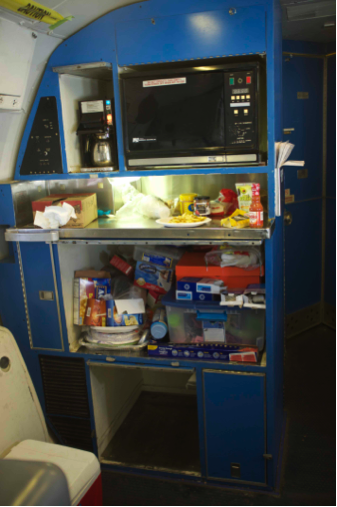
The DC-8 mess. Credit: Joshua Schwarz

The mess in action: Matt Berry (Mission Director) and Stacy Hughes (Whole-air sampling princess), bringing life to the rear cabin. Stacy is testing a new application of the microwave: to warm her hands because the flight was brutally cold. I think she was heating a New Zealand meat pie as her meal. Credit: Joshua Schwarz
In my experience, there are three foundational elements to a successful research-aircraft dining experience:
The first is fairly easy to achieve: quantity, quantity, quantity. All you need is plenty of candy. Now, flying to Ascension Island, I have a Chilean-version Kit Kat, Nutty Bars (a terrific ace in the hole, which I stocked up on in the U.S. before the mission began), NZ potato chips, apples, prunes (yum!), Crunchie bars, Crispy Rolls (from Chile, these appear to be chocolate-covered corn flakes), Sabor frambuesa batido (raspberry yogurt from Chile), a bag of pimiento olives, and a “sahne-nuss” chocolate nut bar, hummus, and carrots.
These are stashed on the floor between the SP2 rack and the wall, where a chilly breeze keeps everything refrigerated. Of course sweet drinks (hot chocolate and chocolate milk rate high, orange juice is a refined alternative, regional specialties are always worth trying (except for “L&P”, the exception to the rule, popular in New Zealand, but probably inspired by a marriage of Pinesol and simple syrup. Ugh!). This could be a little light for today’s 9 ½ hour trek, but extra treats from the rest of the ensemble can usually be begged. And one can always hope for unexpected treats – on the last flight Jim Elkins (NOAA) passed out macademia nuts; I remember a different mission where we celebrated crossing the equator with cookies.
The scale to a achieve a meisterwerk slides depending on many factors: the availability of foodstuffs at the departure airport (I remember leaving Easter Island with only ramen noodles); the quality of the rest of the crew’s meals (competition is growing more fierce); flight conditions (turbulence quickly narrows the range of possibilities – soups are OUT!); and one’s own standards for a fine dining experience.
My standards are happily very low in this regard. On the flight out of New Zealand, my magnum opus was nachos made with New Zealand tortilla chips (yellow corn, meh), hand cut cheese in the microwave (Colby, quite good), topped with Frank’s Original Hot sauce (one of my contributions to the kitty), and adorned with pureed avocado (the fresh avos in Christchurch were all rock hard). In the old days, simply bringing a frozen Indian meal (I’m a tikka masala man) was sufficient to set the bar. I do have plans to perfume a pig, and hope to extend a ramen soup with a fresh egg, cheese, and sesame oil. I considered making ceviche, but decided against the risking a fishy-smelling cabin for the rest of the mission.
To ensure that your meal is appropriately obvious to the others on the plane, I recommend a highly scented hot meal marched up and down the aisle as you eat. On the New Zealand flight, I used a “hot scotch toffee cake” to spread a warm glow of sweetness through the cabin. Leadership by example, I say! Let’s not let these hard-thinking scientists forget to keep every tool in their chest oiled and ready for use in the service of science, society, and high altitude gastronomy.
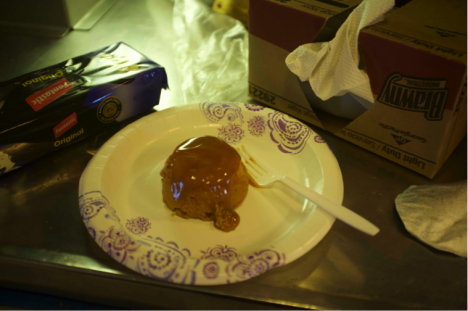
The “meisterwerk” hot scotch toffee cake. Credit: Joshua Schwarz
Joshua “Shuka” Schwarz is part of Chemical Sciences Division at NOAA and is investigating black carbon throughout the atmosphere.
As the DC-8 flies around the world for the ATom project, we are crossing many time zones and occasionally loosing and gaining days! For most of the first half of the project, I didn’t really notice these time changes. I gained the most time leaving Boston for California and had one to two hourly stretches in the evening after that. This has meant that getting up for 4 a.m. pre-flights has actually been do-able! I thought I was doing great — for a night owl. We lost time last week when flying from American Samoa on Monday morning and arriving into New Zealand on Tuesday afternoon. But I had already lost track of the day of the week so that didn’t really have any impact on my routine. In New Zealand, I finally had the time to take a whole day off (for the first time in over 2 weeks!) so we explored Aoraki/Mt. Cook National Park for a few hours.

Snow blowing from the mountains onto the glacier in Aoraki/Mount Cook National Park, New Zealand. Credit: Róisín Commane
And then there was the flight from Christchurch, New Zealand to Punta Arenas, Chile.
We gained back the lost day and more as we flew 10 hours from Christchurch on Saturday morning to arrive in Chile at 4 a.m. on Saturday morning. My poor body clock has no idea which way is up! On the plus side, maybe this body clock mayhem will make the 3:30 a.m. wake up call for our pre-flight tomorrow slightly less ruthless? Wishful thinking perhaps.
But at least the flight from New Zealand was worth all the effort! We flew south from New Zealand to 65 degrees S, profiling from the top to the bottom of the atmosphere as much as we could. We saw Antarctic sea ice, lots of sea salt particles and not at lot of CO at the low altitudes, while at the highest altitudes we saw the Polar vortex and its -70 degrees C temperatures. We also saw CO2 over 401 parts per million (ppm) for most of the flight.

Watching the sun set mid-way through our flight from New Zealand to Punta Arenas, Chile. Credit: Róisín Commane
There is a wonderful exhibit in our hotel here in Punta Arenas about Shackleton’s Trans-Antarctic Expedition (1914-1917) from Chile to Antarctica, which included the great Irish-man Tom Crean. Disaster befell the expedition in Antarctic waters and resulted in five men (including Crean and Shackleton) sailing a 20-foot boat across 700 plus miles of Southern ocean to get help. After seeing the choppy seas of the Southern Ocean on our last flight, I have no idea how they found the island of South Georgia. But hopefully we will have just as good luck as they did when we venture east again to find Ascension Island in the middle of the South Atlantic tomorrow.
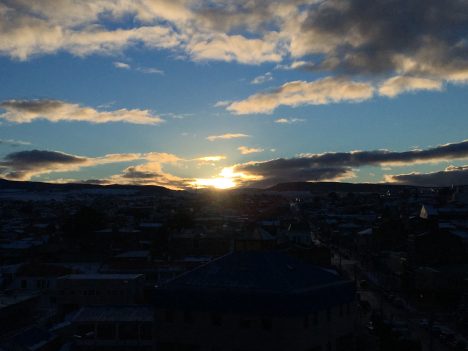
Our first sunset in Punta Arenas, Chile. Credit: Róisín Commane